
Classification
Domain: Eukarya
Members of this domain have cells that contain a nucleus and
membrane bound organelles. Members of domains Bacteria and Archaea are prokaryotes, without nuclei.
Kingdom: Animalia
Organisms in this kingdom are multicellular, lack cell walls,
heterotrophic, and reproductive cells have a single reproductive
flagella at the base.
Phylum: Chordata
Members of this phylum have 3 types of tissue,
ectoderm, endoderm, and mesoderm. They also have a fluid-filled
cavity called a coelom, bilateral symmetry, a notochord, dorsal
nerve cord, thyroid gland, postanal tail, and pharyngeal glands.
Class: Mammalia
Members of this class have bodies covered in hair, the
presence of glands, are warm-blooded or homeothermic, and
generally have live births with a few exceptions, but the yak is
not one of those exceptions.
Order: Artiodactyla
Mammals in this order are divided partly the morphological
feature of hooves. Animals with hooves are call
ungulates. The
animals in the order Artiodactyla are even-toed ungulates,
meaning that they stand on an even number of toes rather than an
odd number. A
horse is an example of an odd-toed ungulate and so is not in
this order. They also have pulley-like structures on a part of
their ankle joint, which allows for more flexibility. Other
members of Artiodactyla include the
pig and the
camel.
include the
pig and the
camel.
Family: Bovidae
This family consists of all ruminants, animals that have a
rumen. You can read more about the rumen on the
Adaptation page. They lack upper
incisors and canines. These animals also have unbranched horns,
they also have a space between the two layers that make up these
horns, so that these animals are called "hollow-horned
ungulates."
Genus: Bos
This genus contains the wild and domesticated cattle
and oxen. There are a total of 5 species in the genus
Bos. All five of these species have changed over time due to
domestication, and so the division into 5 species is based on morphological
qualities.
Species: Bos grunniens
Commonly known as the domesticated yak. The genus "Bos"
means "an ox" and the species part, "grunniens" means
"I grunt" and comes from the habit of yaks to grunt, most often
in their search for a mate. So Bos grunniens and ox
that grunts. The common name, yak may come from the Tibetan word
"g-yag" which means male yak, or it may come from the
Russian word "як" which means and sounds
like "yak".
Find out where the Yak makes its home on the
Habitat page, or go back to the
Home page.
